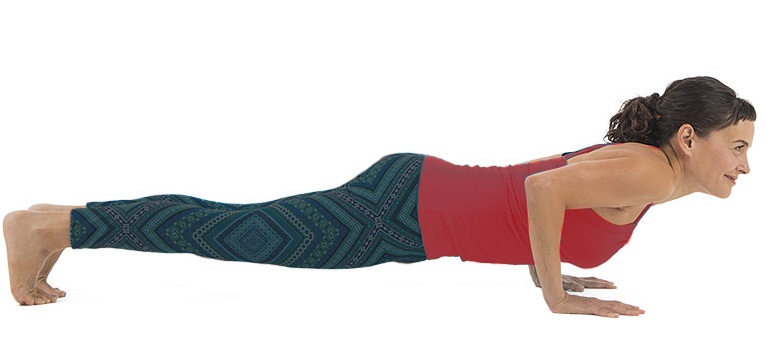The word ‘Chaturanga Dandasana’ comes from Sanskrit, in which the meaning of Chatur is “four”, Anga means “limbs”, danda means “staff” and meaning of Asana is the seat, pose or posture. In this pose our both hands and legs are used so that’s why this is called a four-limbed staff pose and also known as low plank pose.
In this Chaturanga Dandasana, you have to keep your body parallel to the floor and which is supported by your toes and palms with elbows at a right angle but not touching the floor. Chaturanga Dandasana looks much like a push-up pose, but with the hands very low (simply over the pelvis), and the elbows kept in at the edges of the body.
Name: – Chaturanga Dandasana
Meaning: – Four- limbed Staff pose
Preparatory poses: – Phalakasana, Urdhva Mukha Svanasana, and Bhujangasana
Follow-up poses: – Urdhva Mukha Svanasana, Adho Mukha Svanasana
Position: – Arm balancing, push up position
Steps of Chaturanga Dandasana
- First, take a position of Downward facing dog pose (Adho Mukha Svanasana) after that come into plank pose (Note that your shoulder bones are pushed immovably against your back and that your tailbone is pushed towards the pubis.)
- Keep your arms fully extended and keep your spine completely erect.
- Breathe out, bend your elbows, and keep down your lower body towards the ground but not touching it, stop at a point when you are few inches away from the floor or ground.

- Keep your body parallel to the ground and your hips ought to be straight. Turn your legs inward during this position.
- Keep wide space between your shoulder blades.
- Your elbows ought not to be spread outwards but rather be pushed back downwards towards the heel.
- Assure that your neck is adjusted straight with the rest of the body and press the base of your forefingers to the ground.
- Remain in this position for around 10-30 seconds and after that breathe out and rests gently on the floor.
- Repeat this process for 3 to 6 times.
(Try not to sink your middle beneath the elbow level since this puts a considerable measure of weight on the elbow joints. While doing this attempt to bring your mid-section up and convey the heaviness of the body just as between the upper and the lower body – push your heels back.)
Modifications: –
If you are unable to attempt this Asana properly, in that case, you can keep your knees on the floor.
Benefits of Chaturanga Dandasana
- Strengthens arms, wrists and abdomen.
- Beneficial for those people who are suffering from back problems because it strengthens the back muscles.
- Boost flexibility, balance and stability.
- Makes your triceps and biceps strong.
- Gives strength to the muscles of the wrists.
- It tones the abdomen.
- Gives strength to the core abdominal muscles.
NOTE: – Pregnant women and people having wrist injury or in case of carpal tunnel syndrome avoid this. Do yogic activities in a proper way under the supervision of an expert.

